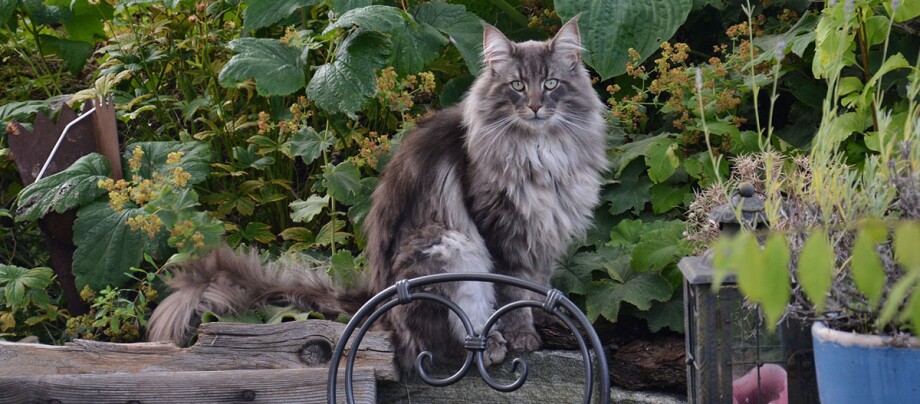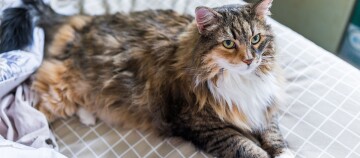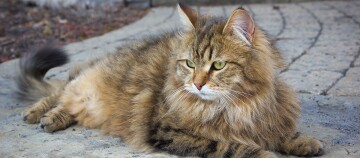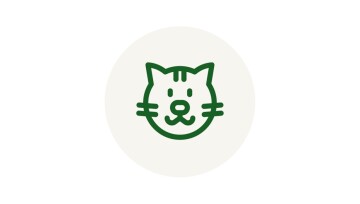Norwegian Forest Cat - Sociable & Friendly and Great Family Cat
01.01.2024 - Reading time: 3 minutes

You want a cat that looks primal and still has a people-oriented, friendly character? With its semi-long hair and lynx-like ears the Norwegian Forest cat is a very special beauty. While it looks like it just leapt out of the wilderness, it is actually a real cuddler with a gentle nature. What also captivates the admirers of this Norwegian is the centuries-long history of the Norwegian Forest cat, which is among the largest pedigree cats.
NewsletterNorwegian Forest Cat
Breed | Norwegian Forest Cat |
Origin | Norway |
Size | big to very big, head-shoulder length 100 to 130 centimetres |
Weight | Female cat 4 to 8 kilograms, tomcat 5 to 9.5 kilograms, in exceptional cases up to 12 kilograms |
Physique | elegant, powerful, long-legged, elongated |
head shape | triangular with a powerful chin and slightly rounded brow |
Eyes | big, oval, all colours are allowed |
Coat and colour | semi-long coat with woolly undercoat and water-repellent top hair on the back and flanks, with a dense ruff on the winter coat; all colours except for lilac, chocolate, cinnamon and fawn are allowed |
Coat care | easy to groom, but must be brushed several times weekly during shedding |
Special features | large paws with interdigital membranes to use as snow shoes, gifted climber |
Nature | friendly, attentive, intelligent, steadfast, needs to be active |
History of the Norwegian Forest cat
For centuries, fairy tales and songs tell of forest, fairy and troll cats. Its archetype probably developed from short haired cats that migrated from central Europe to the northern regions. It is not absolutely clear. In any case, the rough climate in Scandinavia certainly contributed to the fur of the cat growing longer and denser due to evolution. As the Norwegian Forest cat interbred more with short haired domestic cats, a Norwegian breeder began to rescue their genes in the 1930s. The first Forest cat showed up at an exhibition before the Second World War. The international breeding association FIFe recognised the first male cat in 1977. His picture was even shown in the news on Norwegian television. Actually, even today representatives of the breed live freely and independent of humans in the forests of Norway. The Norwegian Forest cat is also visually very similar to the European wildcat.
Appearance of the Norwegian Forest cat
A striking feature of the Norwegian Forest cat is its ears, which have small tufts of hair that stick out on the tips. The elegant beauty from the high north also wears a shirt front, ruff, and knickers. This describes the luxuriant fur that the Norwegian Forest cat sports on its throat, chest and hind legs of its winter coat. In these areas, the soft, thick undercoat is particularly lush during the cold times of the year and is covered with long, slightly oily awn hairs. These protect the cat from wetness. The beautiful Norwegian is also otherwise perfectly suited to life in the cold forests of its home: its hind legs are slightly longer than the forelegs. This enables the cat to jump very well and makes it into an excellent hunter. The spread-out paws also help to distribute its weight on the snow better in winter.
The colour and pattern spectrum that is allowed by the breeding standard is very big: only the colours of chocolate, cinnamon, lilac and fawn are not recognised.
Norwegian Forest cat: nature
These animals are known for their gentle and cuddly nature despite looking like a wild cat. They actually love cuddles and require a lot of attention from their humans. You should also plan sufficient time for play. With their friendly nature and strength of character, Norwegian Forest cats are pleasant housemates. They are extremely sociable, which is why keeping it alone is no recommended.

Norwegian Forest cats: keeping and care
The Norwegian Forest cat climbs, jumps, and has a strong need to be active. Due to its size keeping these powerhouses as purely indoor cats is only recommended if necessary. Unless, that is, you can provide the cats with lots of space at home. Shedding during spring is a real challenge. During this time, the cat sheds its whole undercoat, which means you have to brush your house cat regularly. Otherwise, the Norwegian Forest cat is easy to care for and uncomplicated. It’s life expectancy is around 15 years on average, so you will have a lot of time together.
Video: “All about the Norwegian Forest cat”
Breed portrait: Norwegian Forest cat
In this video, we would like to introduce you to the Norwegian Forest cat. It is a very primal cat breed and looks a bit wild with its thick fur. But at its heart it’s a big cuddly toy. It likes people a lot, is affectionate and sociable – and as such is a great family cat.





